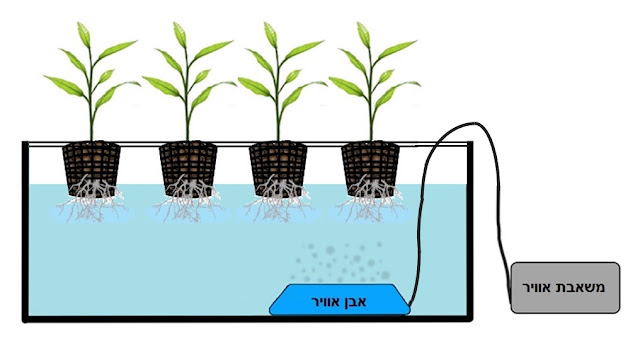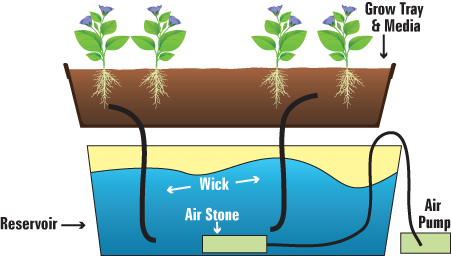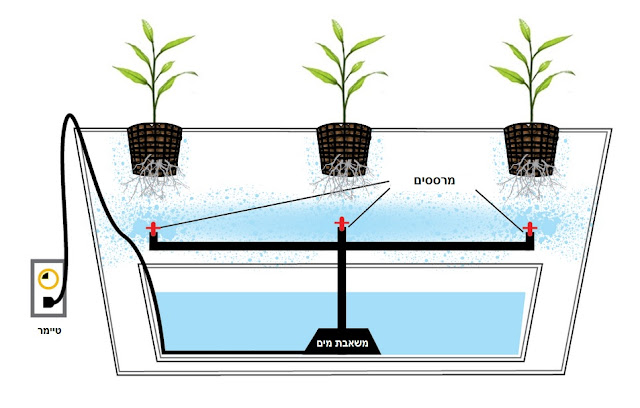Best Hydroponic Growing System
Best Hydroponic Growing System - lintangsore.net
Hydroponic systems produce growth rates ten times faster than standard planting and watering.
This means you can have beautiful, blooming flowers in your garden, or even tasty, organic vegetables on your plate, much more quickly.
When you planting hydroponically, there are a lot of different factors that need to be handled simultaneously in order to produce a good yield. Your plants need just the right amount of light, water, nutrients, heat and humidity in their environments to thrive. A successful grow ops require a lot of materials, including grow tray, reservoir, hydroponic lights, pots, growing medium, nutrients, ventilation and more. Grow tents or grow cabinets are not absolute requirements, but they can be a good way of isolating your plants from the outside environment so that you can maintain the perfect level of heat and humidity.

Most Popular System Types:
This method is probably the most high-tech type of hydroponics gardening. Aeroponics Systems use little to no growing medium. The roots hang in the air and are misted with nutrient solution. The misting are usually done every few minutes. Because the roots are exposed to the air, the roots will dry out rapidly if the misting cycles are interrupted.
A timer controls the nutrient pump much like other types of hydroponic systems, except the aeroponics system needs a short cycle timer that runs the pump for a few seconds every couple of minutes. Other types of Aeroponics systems run constantly, requiring no timer.
These systems are easily contaminated by rot-inducing anaerobic bacteria, and should only be used by experienced gardeners and researchers.

This is the most effective hydroponic system. Plants are in a basket of grow rocks, suspended over a container of aerated nutrient solution. An air pump supplies air to the air stone that bubbles the nutrient solution and supplies oxygen to the roots of the plants.
Water culture is the system of choice for growing leaf lettuce, which are fast growing water loving plants, making them an ideal choice for this type of hydroponics system. Very few plants other than lettuce will do well in this type of system, although it can work well for the vegetative stage of flowering plants. This type of hydroponics system is great for the classroom and is popular with teachers.
A very inexpensive system can be made out of an old aquarium or other water tight container. The biggest draw back of this kind of system is that it doesn't work well with large plants or with long-term plants.

This method is probably the most widely used type of hydroponic system in the world. Operation is simple, a timer controls a submersed pump. The timer turns the pump on and nutrient solution is dripped onto the base of each plant by a small drip line.
In a Recirculating Drip System the runoff is collected back in the reservoir for re-use. The Water-to-Waste System does not collect the runoff. The advantage of Water-to-Waste is that the nutrient solution in the reservoir has never passed through the system, so it is unchanged. In a Recirculating System, the nutrient solution can fluctuate in both nutrient concentration levels and pH levels.
We recommend a soilless mix for Water-to-Waste systems, because soilless mixes retain more water. This way, the pump kicks on less often, so you use less nutrient solution. With quality nutrients and a good soilless mix, a Water-to-Waste Drip System can be one of the best ways of gardening with lights.

Ebb and Flow works by temporarily flooding the grow tray with nutrient solution and then draining the solution back into the reservoir. This action is normally done with a submerged pump that is connected to a timer. When the timer turns the pump on nutrient solution is pumped into the grow tray. When the timer shuts the pump off the nutrient solution flows back into the reservoir. Depending on plant requirements, the tray can be flooded once, or several times, each day.
The main disadvantage of this type of system is that with some loose types of growing medium (Growrocks, Perlite, etc.), there is a vulnerability to power outages as well as pump and timer failures. The roots can dry out quickly when the watering cycles are interrupted. This problem can be relieved somewhat by using growing media that retains more water (Rockwool, coconut fiber or a good soilless mix).
This is the system we often recommend for first-time hydroponics gardeners. It is simple, reliable, and easy to set up.

N.F.T. systems have a constant flow of nutrient solution so no timer is required for the submersible pump. The nutrient solution is pumped into the growing tray (usually a tube) and flows over the roots of the plants, and then drains back into the reservoir.
Normally the plant is supported in a small plastic basket full of grow rocks, with the roots dangling into the nutrient solution. N.F.T. systems are very susceptible to power outages and pump failures. The roots dry out very rapidly when the flow of nutrient solution is interrupted.
There is usually no growing medium used other than air, which saves the expense of replacing the growing medium after every crop. Normally the plant is supported in a small plastic basket with the roots dangling into the nutrient solution.
The Passive System: This is almost identical to growing a plant in a container of soil. The difference is that instead of soil, you would use a soilless mix. Soilless mixes can be a variety of substances including rockwool, peat moss, coconut coir, perlite, vermiculite, tree bark, etc.

This is by far the simplest type of hydroponics system. This is a passive system, which means there are no moving parts. The nutrient solution is drawn into the growing medium from the reservoir with a wick. This system can use a variety of growing mediums. Perlite, Vermiculite, Pro-Mix and Coconut Fiber are among the most popular.
The biggest draw back of this system is that plants that are large or use large amounts of water may use up the nutrient solution faster than the wick(s) can supply it.

Yes, an aquaponic system actually features real, living fish! Far from being a novelty hydroponic system though, this arrangement actually creates an intricate ecosystem that benefits both the plants and the aquatic life swimming below!
In an aquaponic system, the fish are essentially living in the nutrient reservoir. Their excrement releases ammonia into the water, as does any uneaten food. Ammonia is toxic to fish, and if they remain in water filled with ammonia they will die; therefore, it must be removed to keep them healthy.
The good news for the plants in the aquaponics system is that the fish are effectively creating a natural fertilizer for them. When bacteria mixes with the ammonia in the water it will turn into nitrate, one of the nutrients that is essential for optimal plant growth. This is then pumped into the growtray where it is fed to the plants.
As the plants absorb the nutrients they remove the toxins from the water. The runoff, now free from ammonia, is then drained straight bank into the nutrient reservoir, where the fish live.
Clever right? The fish benefit the plants by providing them with a naturally produced fertilizer. The plants benefit the fish by removing toxins from the water, leaving it fresh and clean when it is returned to the tank. As I said at the start, a complex ecosystem, but one that is extremely effective.
It is also a lot more fun to look at, and a devious way to get your children interested in hydroponics!
Hydroponic systems produce growth rates ten times faster than standard planting and watering.
This means you can have beautiful, blooming flowers in your garden, or even tasty, organic vegetables on your plate, much more quickly.
When you planting hydroponically, there are a lot of different factors that need to be handled simultaneously in order to produce a good yield. Your plants need just the right amount of light, water, nutrients, heat and humidity in their environments to thrive. A successful grow ops require a lot of materials, including grow tray, reservoir, hydroponic lights, pots, growing medium, nutrients, ventilation and more. Grow tents or grow cabinets are not absolute requirements, but they can be a good way of isolating your plants from the outside environment so that you can maintain the perfect level of heat and humidity.

Best Beginner Hydroponic System
These hydroponic systems are a perfect solution not only for beginners, but for anyone with a limited amount of space. They are easy to set up, simple to use and don’t take up a lot of space.Most Popular System Types:
The Aeroponics System:
This method is probably the most high-tech type of hydroponics gardening. Aeroponics Systems use little to no growing medium. The roots hang in the air and are misted with nutrient solution. The misting are usually done every few minutes. Because the roots are exposed to the air, the roots will dry out rapidly if the misting cycles are interrupted.
A timer controls the nutrient pump much like other types of hydroponic systems, except the aeroponics system needs a short cycle timer that runs the pump for a few seconds every couple of minutes. Other types of Aeroponics systems run constantly, requiring no timer.
These systems are easily contaminated by rot-inducing anaerobic bacteria, and should only be used by experienced gardeners and researchers.
The Deep Water Culture System:

This is the most effective hydroponic system. Plants are in a basket of grow rocks, suspended over a container of aerated nutrient solution. An air pump supplies air to the air stone that bubbles the nutrient solution and supplies oxygen to the roots of the plants.
Water culture is the system of choice for growing leaf lettuce, which are fast growing water loving plants, making them an ideal choice for this type of hydroponics system. Very few plants other than lettuce will do well in this type of system, although it can work well for the vegetative stage of flowering plants. This type of hydroponics system is great for the classroom and is popular with teachers.
A very inexpensive system can be made out of an old aquarium or other water tight container. The biggest draw back of this kind of system is that it doesn't work well with large plants or with long-term plants.
The Drip System:

This method is probably the most widely used type of hydroponic system in the world. Operation is simple, a timer controls a submersed pump. The timer turns the pump on and nutrient solution is dripped onto the base of each plant by a small drip line.
In a Recirculating Drip System the runoff is collected back in the reservoir for re-use. The Water-to-Waste System does not collect the runoff. The advantage of Water-to-Waste is that the nutrient solution in the reservoir has never passed through the system, so it is unchanged. In a Recirculating System, the nutrient solution can fluctuate in both nutrient concentration levels and pH levels.
We recommend a soilless mix for Water-to-Waste systems, because soilless mixes retain more water. This way, the pump kicks on less often, so you use less nutrient solution. With quality nutrients and a good soilless mix, a Water-to-Waste Drip System can be one of the best ways of gardening with lights.
Best Hydroponic System 2016
The Ebb and Flow System:

Ebb and Flow works by temporarily flooding the grow tray with nutrient solution and then draining the solution back into the reservoir. This action is normally done with a submerged pump that is connected to a timer. When the timer turns the pump on nutrient solution is pumped into the grow tray. When the timer shuts the pump off the nutrient solution flows back into the reservoir. Depending on plant requirements, the tray can be flooded once, or several times, each day.
The main disadvantage of this type of system is that with some loose types of growing medium (Growrocks, Perlite, etc.), there is a vulnerability to power outages as well as pump and timer failures. The roots can dry out quickly when the watering cycles are interrupted. This problem can be relieved somewhat by using growing media that retains more water (Rockwool, coconut fiber or a good soilless mix).
This is the system we often recommend for first-time hydroponics gardeners. It is simple, reliable, and easy to set up.
The N.F.T. System:

N.F.T. systems have a constant flow of nutrient solution so no timer is required for the submersible pump. The nutrient solution is pumped into the growing tray (usually a tube) and flows over the roots of the plants, and then drains back into the reservoir.
Normally the plant is supported in a small plastic basket full of grow rocks, with the roots dangling into the nutrient solution. N.F.T. systems are very susceptible to power outages and pump failures. The roots dry out very rapidly when the flow of nutrient solution is interrupted.
There is usually no growing medium used other than air, which saves the expense of replacing the growing medium after every crop. Normally the plant is supported in a small plastic basket with the roots dangling into the nutrient solution.
The Passive System: This is almost identical to growing a plant in a container of soil. The difference is that instead of soil, you would use a soilless mix. Soilless mixes can be a variety of substances including rockwool, peat moss, coconut coir, perlite, vermiculite, tree bark, etc.
The Wick System:

This is by far the simplest type of hydroponics system. This is a passive system, which means there are no moving parts. The nutrient solution is drawn into the growing medium from the reservoir with a wick. This system can use a variety of growing mediums. Perlite, Vermiculite, Pro-Mix and Coconut Fiber are among the most popular.
The biggest draw back of this system is that plants that are large or use large amounts of water may use up the nutrient solution faster than the wick(s) can supply it.
The Aquaponics System:

Yes, an aquaponic system actually features real, living fish! Far from being a novelty hydroponic system though, this arrangement actually creates an intricate ecosystem that benefits both the plants and the aquatic life swimming below!
In an aquaponic system, the fish are essentially living in the nutrient reservoir. Their excrement releases ammonia into the water, as does any uneaten food. Ammonia is toxic to fish, and if they remain in water filled with ammonia they will die; therefore, it must be removed to keep them healthy.
The good news for the plants in the aquaponics system is that the fish are effectively creating a natural fertilizer for them. When bacteria mixes with the ammonia in the water it will turn into nitrate, one of the nutrients that is essential for optimal plant growth. This is then pumped into the growtray where it is fed to the plants.
As the plants absorb the nutrients they remove the toxins from the water. The runoff, now free from ammonia, is then drained straight bank into the nutrient reservoir, where the fish live.
Clever right? The fish benefit the plants by providing them with a naturally produced fertilizer. The plants benefit the fish by removing toxins from the water, leaving it fresh and clean when it is returned to the tank. As I said at the start, a complex ecosystem, but one that is extremely effective.
It is also a lot more fun to look at, and a devious way to get your children interested in hydroponics!

Positive site, where did u come up with the information on this posting?I have read a few of the articles on your website now, and I really like your style. Thanks a million and please keep up the effective work. best gardening tools
ReplyDelete